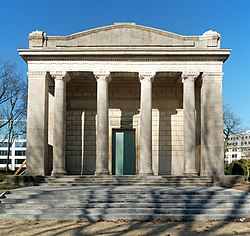
Back Templo de las pasiones humanas Spanish Pavillon des Passions humaines French Paviljoen van de Menselijke Driften Dutch 人类激情之庙 Chinese
| Pavilion of Human Passions | |
|---|---|
 | |
 | |
| Alternative names | Horta-Lambeaux Pavilion |
| General information | |
| Architectural style | |
| Address | Parc du Cinquantenaire / Jubelpark |
| Town or city | 1000 City of Brussels, Brussels-Capital Region |
| Country | Belgium |
| Coordinates | 50°50′35.02″N 4°23′14.48″E / 50.8430611°N 4.3873556°E |
| Current tenants | Saudi Arabia (until 2068)[1] |
| Construction started | 1892 |
| Completed | 1896 |
| Inaugurated | 1 October 1899 |
| Renovated | 2014[2] |
| Cost |
|
| Renovation cost | €800,000[2] |
| Client | Belgian Government |
| Owner | Belgian Government |
| Landlord | Royal Museums of Art and History |
| Technical details | |
| Floor area | 20 by 15 metres (66 ft × 49 ft) |
| Design and construction | |
| Architect(s) | Victor Horta |
| Other designers | Jef Lambeaux |
| Main contractor | Alphonse Balat[1] |
| Website | |
| Official website | |
The Pavilion of Human Passions (French: Pavillon des Passions humaines; Dutch: Paviljoen der Menselijke Driften), also known as the Horta-Lambeaux Pavilion, is a neoclassical pavilion in the form of a Greek temple that was built by Victor Horta in 1896 in the Parc du Cinquantenaire/Jubelpark of Brussels, Belgium. Although classical in appearance, the building shows the first steps of the young Victor Horta towards Art Nouveau. It was designed to serve as a permanent showcase for a large marble relief The Human Passions by Jef Lambeaux.
Since its completion, the building has remained almost permanently closed. Since 2014, the building is accessible during the summer time.[2]
- ^ a b c De Ruyck, Jo (5 April 2012). "Koning Boudewijn vroeg Saudi's om erotisch tafereel te verstoppen". De Standaard (in Dutch). Retrieved 5 April 2012.
- ^ a b c Duplat, Guy (31 July 2015). "Les passions "scandaleuses" dans le marbre" ["Scandalous" passions in marble]. lalibre.be. Retrieved 1 August 2015.